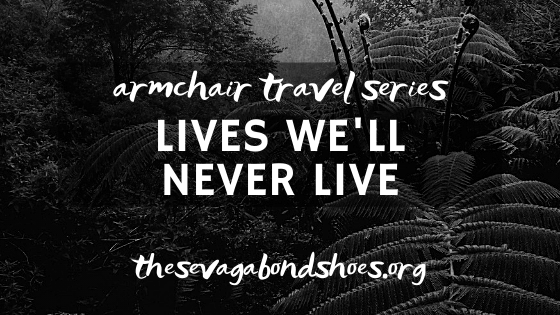A selection of my favourite books about other people’s lives: those living traditional lives in remote communities; people living in unique circumstances as a result of conflict or disaster; and ways of life now long gone.
This edition of Armchair Travel is all about those lives less ordinary, experiences often far removed from our own everyday existance. These books explore different cultures from around the world, written by insiders as well as outside observers; lives in a state of transition and those being rebuilt after conflict and trauma; and snapshots of a traditional way of life now irreversibly changed.
Here are 10 books that bring an insight into a way of life that we’ll never live ourselves.
A Death in the Rainforest: How a Language and a Way of Life Came to an End in Papua New Guinea – Don Kulick
As a young anthropologist, Kulick travelled to a small settlement in the Sepik River region of Papua New Guinea to document the decline of the Tayap language isolate. Over repeated visits he immerses into the tribal culture, and gains an understanding of a way of life on the verge of disappearing forever. While individual losses provide the moments of most acute sadness, he shows the real tragedy is the complex web of events leading to the loss. The book is also a perceptive interrogation of anthropology, and a deep look into the impact of western colonialism on the farthest reaches of the earth. Get it here.
She is brave and strong and broken all at once. As she speaks it is as if her existence is no longer real to her in itself, more like a living epitaph to a life that was.
Anna Funder – Stasiland
Stasiland: Stories from Behind the Wall – Anna Funder
On 9th November 1989, the Berlin Wall fell, and as East Germany ceased to exist the extent to which the state secret police, the Stasi, held the country in its grip was revealed. This is a blend of Funder’s personal travelogue in the immediate post-reunification years with a series of interviews that tell extraordinary personal stories. The insidious presence of the Stasi, controlling and manipulating in all aspects of society, created a poisoned atmosphere of distrust and suspicion that forever altered people’s lives. A truly harrowing insight into life in a totalitarian state, and into a country no longer physically split by a border, but at the time of writing, still very much ideologically divided. Buy it here.
Down and Out in Paris and London – George Orwell
A memoir, though fictionalised, of the time Orwell spent living alongside the desperately poor and destitute in both Paris and London in the 1920s and 30s, which painstakingly documents a shocking world of unrelenting squalor and drudgery. He mixes with the overlooked underclass, sleeping in hostels and doss houses, working menial jobs, and surviving on scraps and cigarette ends, as he explores the cities’ underbelly. It contains a number of views which are problematic and a product of their era, and should be read with this is mind, but it is still a shocking exposé of the underclass of society, giving an accessible human face to grinding poverty, and setting a precedent for writes of similar works to follow. Find it here.
The Old Man and His Sons – Heðin Brú
An account of daily life in the wave-washed Faroe Islands some seventy years ago, set against the creeping modernisation of society. The opening chapter details the grindadráp, the communal whale hunt, in all its bloody spectacle. Drunk on the adrenaline of the hunt, Ketil, the old man of the title, buys whale meat beyond his means, and with the assistance of his youngest son sets out on a series of adventures to ease the debt. With intergenerational conflict, and the gulf between the old and the new, tradition and change, as the theme, this novel is a glimpse into a way of life on the brink, which does not shy from showing the precariousness of existence or the foolishness of certainty in uncertain times. Find it here.
The Shaman’s Coat: A Native History of Siberia – Anna Reid
Comprising almost 60% of the landmass of Russia, surprisingly little of Siberia’s story features in histories of Russian imperialism, revolution and socialism. Historian Anna Reid travels the region following the break-up of the Soviet Union, meeting representatives of some indigenous groups, from the Bibiyaki in western Siberia to the Chukchi in the far east. She tells of the Russian colonisation of Asia through the 17th and 18th centuries, forced Russification of peoples from many different ethnicities, with diverse languages and traditions, through to resettlement and collectivisation under communism. Only a few strong outposts of native culture remain, but some glimmers of hope lie in the ruins of the USSSR. A beautifully written introduction to a subject on a sweeping scale, in both time and space. Get it here.
Tell My Horse: Voodoo and Life in Haiti and Jamaica – Zora Neale Hurston
Writer and folklorist Zora Neale Hurston gives an account of her experiences in Jamaica and Haiti in the 1930s, as she documented voodoo rituals and practices. The book is both an anthropological text and a memoir; rather than giving cool, scholarly observations of ceremonies and rituals, she is an active participant, and bringing a personal connection and insider knowledge to her subject. Hurston also explores the shared African heritage of black Jamaicans, Haitians, and Americans, and the relationship of traditional animist beliefs to their lived experiences in the 1930s. Read it here.
Soldiers of Light – Daniel Bergner
A deeply moving narrative of a journey into heart of Sierra Leone by journalist Daniel Bergner. In the aftermath of the bloody and brutal civil war of the 1990s, which killed more than 50,000 and displaced hundreds of thousands more (before the 2014-16 outbreak of ebola), he tells the stories of those he encounters as they rebuild shattered lives and reconcile with the impact of the war. Child soldiers, victims of violence, nuns and priests that attempted to provide sanctuary, and former dictator and warlord Valentine Strasser, provide testimonies alongside those of western missionaries, aid workers, mercenary fighters, and British Army officers from the peacekeeping force deployed to the country. All in some way are haunted by the events that defined their experience. Get it here.
Split Tooth – Tanya Tagaq
Moving between memoir and fiction, poetry and prose, the gritty reality of life in the Arctic and exhilarating supernatural fantasy, this is a book with a strange and powerful magic. Tagaq tells a powerful story of a teen Inuk girl in a small village in far north Nunavut in the 1970s, where life is shaped by violence, substance abuse and addiction, and sexual abuse, interwoven with a dreamlike world of spirits, myth, visions, and Arctic nature. This is an visceral and beautiful representation of the experience of indigenous women, written with honesty and tenderness, and will linger long in your mind after reading. Find it here.
The Guga Hunters – Donald S. Murrary
In the recent past, seabirds and their eggs were a staple food for many small communities clinging to the Atlantic fringes of Europe. Ness (Nis), at the northernmost tip of the Hebrides, is the only community in the British Isles that retains the tradition. Men of the village undertake an arduous expedition to Sula Sgeir, a rocky sea-stack 40 miles offshore, living on the rock for a couple of weeks or so to capture gannet chicks, known as guga. The book is a fascinating insight into a history that would have been shared by coastal communities in the north Atlantic, and how the tradition is rooted deeply in the language and culture of the region. Read it here.
Just as books are read one word at a time, roads are taken one step at a time.
Xinran – Sky Burial
Sky Burial: An Epic Love Story of Tibet – Xinran
One of the most beautiful books I’ve ever read. Simple, sparse writing draws you into the into the story of Chinese woman Shu Wen, and her quest to find what became of her husband, Kejun, disappeared in Tibet. For such a slim book, the scale of the story is epic, fitting the vastness of the landscape through which Wen travels and her gradual transformation from an outsider, a Chinese observing Tibetan culture, to becoming fully absorbed into the life through her everyday survival. As an insight into the nomadic way of life in mid-century Tibet, it is fascinating and compelling, an intimate portrait of traditions, spirituality, and the minutiae of day-to-day living. Find it here.
Have you read any of these books? I’d love to hear your recommendations; let me know what you think in the comments.
Did this post capture your imagination? Why not pin it for later?

This post contains affiliate links. If you purchase through my link, I will make a small commission* at no additional cost to you. These help me to continue to run this site, providing tips and advice, and sharing stories from my adventures. Thank you for supporting me.
*Maybe enough for a coffee. Not enough for a yacht.


